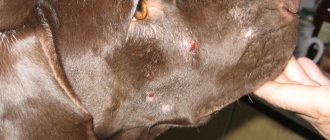The disease caused by ear mites in dogs is called otodectosis or ear scabies. The ear mites themselves - Otodectes cynotis - are very small, up to 0.5 mm in size. They can only be seen under a microscope, but they live on the skin inside the ear. The tick's mouthparts are designed in such a way that they pierce and tear the epidermis (the top layer of skin) and feed on lymph. Because they cannot eat solid food, that is, the skin itself.
The tick development process from egg to imago (adult) takes about 20 days. The ears provide the most favorable conditions for otodexes. Outside the auricle, even on the fur next to the ear, mites do not reproduce and live only about 20 days, and when exposed to high and low temperatures they die within 1 to 5 days (depending on the degree).
Why are ear mites dangerous?
In the early stages of infection, mites do not pose a great danger, however, they cause discomfort and severe itching for the dog.
At this stage, ear mites are very easy to remove.
If no measures are taken, otodectosis will eventually cause otitis media - inflammation of the ear, which moves from the auricle to the middle ear, possibly even perforating the membrane.
In very severe and advanced cases, a common ear mite can lead to meningitis - inflammation of the brain and even death.
Harm and danger of the parasite
Without timely treatment, otodectosis not only causes complications, but also leads to death - if it comes to brain infection. The disease is most severely suffered by animals from the risk group with low immunity. Their already poor health is undermined not only by the tick itself, but also by the medications used against it.
For an infected animal
Advanced pathology is complicated by brain damage. An army of arachnid pests gradually gnaws through the eardrum and enters the inner ear. The accumulated pus drains directly into the brain, causing death from meningitis.
“ A less dangerous, but still unpleasant outcome is partial or complete deafness.
Is there a danger to others?
Otodectosis affects many mammals, so a four-legged pet can easily infect a cat, rabbit, ferret or raccoon. The scheme also works in the opposite direction. When living in the countryside, you should be wary of not only wild foxes, but also squirrels.
“If you have several pets, you will have to treat all of them at once - even if the main patient is strictly isolated.
Only humans should not be afraid, since ear mites do not take root on their skin and only cause a mild allergy. All symptoms go away on their own soon after the infected dog recovers.
Description of the disease
Otodectosis is the parasitism of ear mites in the auricle of a dog. Mites multiply quickly because the conditions inside the ear are optimal for them.
During their life, mites damage the skin of the ear canal, cause severe itching, the dog itches heavily, scratches its ears with its claws (leaving open wounds). Various types of bacteria are introduced into wounds with claws.
As a result, we have an auricle infested with mites, bacteria and fungi on damaged skin. Together, these factors lead to severe inflammation that spreads deeper into the ear.
Symptoms of otodectosis and how to recognize ear mites
It will not be difficult for even the most attentive owner to suspect ear mites in a domestic dog.
The main symptom at an early stage is itching.
At first, the dog simply scratches his ears too often, and the further the disease progresses, the more he begins to scratch, and even scratches the inside of the ear with his claws.
The second sign is dirty ears. A black and brown mass of mite waste products, dead epidermis and sulfur accumulates in the auricle. Subsequently, this mass turns into crusts. If you don’t clean your pet’s ears, the entire ear canal literally becomes overgrown with black-brown crusts.
Other symptoms of ear mites that are not so specific:
- redness of the auricle and ulcers on its surface;
- depressed or, on the contrary, too excited state (due to constant itching);
- the ear is swollen;
- constant discharge from the ear is accompanied by an unpleasant odor;
- often shakes his head.
Possible complications
In addition to meningitis, the animal may also face other dangerous complications. These include:
- partial or complete deafness;
- dermatitis and allergies;
- purulent otitis;
- weakening of the body's defenses against the background of extensive intoxication;
- secondary infections;
- formation of ear plugs;
- inflammation and rupture of the eardrum.
Remember that puppies and older dogs tolerate the disease much worse than healthy animals. Because of this, they often die from the consequences in a very short time.
How does infection occur?
Your pet can contract ear mites from contact with a sick animal. This could be another dog on a walk or a street animal. Otodectosis is especially common among stray dogs and cats. Almost every second street dog and cat is a carrier of ear mites.
Fur-bearing animals can also be infected with otodex. So, if your dog had to interact with a ferret, for example, or a fox, then it’s better to watch her ears.
The above applies to domestic animals; contact with wild animals should not be allowed at all.
Prevention of otodectosis in domestic dogs
As you know, any disease is easier to prevent than to treat. By following basic preventive measures, the dog will remain healthy and long, costly and troublesome treatment will be avoided.
Ear mite prevention measures:
- The most effective way to prevent otodectosis is regular treatment with insectoacaricidal agents. It is necessary to use anti-ear mite products from early spring (as soon as the snow melts) until late autumn (before frost).
- Prevention should be carried out regularly throughout the season. You should not delay treating your pet even for a few days, especially if the dog actively communicates on the street with its fellow tribesmen.
- If for some reason the animal is not treated, it is prohibited to allow it to interact with other dogs (especially stray cats).
- The owner must follow the rules of hygiene - wash his hands after going outside, before petting the pet; Don't let your dog lick your shoes.
Diagnostics
An accurate diagnosis of otodectosis can only be made in a clinical setting. It is necessary to take swabs from both ears and examine them under a microscope. Under magnification, you can very clearly see the ticks themselves, and then the diagnosis is obvious.
Thus, when you bring your pet to the clinic, the veterinarian performs the following manipulations:
- External examination of the ears. Based on its results, the smell from the ear canal is determined, possibly wounds from scratching, the presence of dark brown discharge or crusts.
- A scraping is taken for analysis. The manipulation is carried out using a special stick, about 10 cm long, with a cotton swab at the end (it is not recommended to use a regular cotton swab, as the cotton swab can fly off and remain in the ear canal).
- A smear is prepared from the scraping and examined under a microscope. All this does not take much time.
- Next, your pet’s ears will be cleaned and treatment will be prescribed.
Owner stories
Svetlana : “We adopted a dog from a shelter. She constantly scratched one ear. When she was examined by a veterinarian, it was discovered that she had ear scabies. The doctor prescribed Otoferonol Gold drops and said they were effective. Both ears were treated three times. There was a one-week interval between treatments. The dog was cured and the ticks were removed. For prevention, we treated the dog with Prazicide, it helps remove all external parasites.”
Nikita : “I still don’t understand where my dog picked up this infection. I admit honestly that I did not look into the ears of my pet, and did not know how to understand that the dog was sick. We went to the vet when he scratched his ear until it bled. There they took a scraping from us and found a tick under a microscope. The doctor himself cleaned my Rex’s ears, I had no idea how to do it. We were prescribed Stronghold drops for the withers. They need to be used once. A month later we went to the vet and found no ticks on the dog.”
Video:
Treatment
Before adding the drug, it is necessary to clean it from dirt. Treatment will be useless if the ears remain dirty.
In the first days of therapy, you need to clean them twice a day. If you do this yourself, then don’t worry, it’s not difficult, follow these rules:
First, examine the ear from the inside and determine the nature of the discharge.
If they are mushy or even almost liquid, then you can start cleaning.
If the inside of the ear is covered with crusts, they need to be softened. To do this, it is better to use special veterinary lotions for cleaning the ears. But 0.5% chlorhexidine or hydrogen peroxide will cope with this task.
To soften the crusts:
- drop a small amount of solution into the ear, so as to completely wet all the crusts;
- bend the ear so that the solution does not flow out and massage for about a minute;
- After that, let the dog shake its head and you can start cleaning.
To clean your ears, it is better to use a cotton pad or a bandage folded several times. Ordinary cotton wool spreads and gets stuck inside.
Moisten a bandage or cotton pad with ear cleaning lotion or chlorhexidine even after the crusts have softened.
Clean the ear using movements from the inside out, from bottom to top, so as not to push the mixture deeper into the ear canal.
When you have removed the bulk of the discharge, you can take a cotton swab, moisten it with the solution and clean all the bends of the ear. Do not put the stick deep into the ear.
After cleaning, you can begin medical treatment. There are many remedies to combat ear mites. They are often produced in the form of drops, sometimes in the form of an ointment.
The veterinarian should prescribe a specific drug, depending on the stage of the disease, because in advanced cases, your dog may have otitis media, and fungi could get into the wounds, and then you will have to fight all this together.
Usually prescribed:
- Drops Bars;
- Otovedin;
- Amitrazine;
- Vedinol plus (ointment);
- Aurikan and others.
To apply the drug, you just need to drop a few drops (the exact volume depends on the specific product, see the instructions) inside the ear (next to the ear canal, but not directly into it). And hold the dog's ears closed, massaging for about 30 seconds. Then the drug will do its job.
FAQ
How to prepare a dog's ear for treatment?
It is necessary to clear the auditory approach, as described above.
Can a person become infected with ear mites?
No, ear mites are contagious to dogs, cats, ferrets and wild canines.
How are ear mites transmitted?
Transmitted by contact with an infected animal.
What products for hygienic ear cleaning?
Special lotions (Bars, Excel, Otifri and others). Home remedies (chlorhexidine 0.5%, hydrogen peroxide).
Briefly about the main thing
- The ear mite Otodectes cynotis is a microscopic parasite that lives inside the ear canal, pierces the epidermis and feeds on lymph.
- Otodectosis is dangerous because it is complicated by otitis media, and in advanced cases can even lead to death.
- Dogs become infected after contact with another sick dog or cat.
- The most specific symptoms are severe itching and dark brown discharge with an unpleasant odor from the ears.
- For quality treatment, it is necessary to clean the ear canal at least twice a day.
Have we answered your question fully enough? If not, post your question in the comments below and our veterinarian will answer it.
Did you like the article? Share it with your friends on social media. networks. This will help them get useful information and support our project.
The causative agent of the disease
The causative agent is O. cynotis - a scabies mite-carpet beetle of oval, tortoise-shaped shape, off-white color, with a brown tint in places with stronger chitinization. The head, chest and abdomen are fused into one whole. The proboscis is located on the front of the body. Females are much larger than males. The size of females is 0.32-0.75 mm, males 0.2-0.6 mm. In females, the posterior end is rounded, and in males it is equipped with two abdominal processes with a tuft of setae on each. There are four pairs of legs on the ventral side of the tick. Each leg consists of five segments (coxa, trochanter, femur, tibia, tarsus). At the tops of the tarsi there is a soft membranous pretarsus (sucker or ambulacra). The first three pairs of limbs are well developed, the fourth pair is rudimentary in females. The suckers in females are tulip-shaped, located on short non-segmented rods on the first and second pairs of limbs, in males - on all four. The proboscis is gnawing, horseshoe-shaped. Mites live on the surface of the skin and feed on exfoliated epidermal cells, scales and dry crusts of the skin.
The anal and copulative openings are located at the posterior end of the body. The female lays from several dozen to hundreds of eggs during her life. The eggs are oval in shape, covered with a thin shell, 0.18-0.2 mm long and a maximum width of 0.08-0.09 mm.
Arthropod parasites settle in the hearing organs of a pet, injure delicate skin, and their saliva and feces activate irritation and itching. Insects live only on animals, so people do not become infected.
They prefer to feed on lymph, blood and skin particles.











